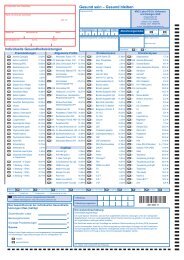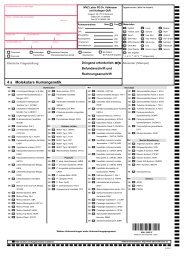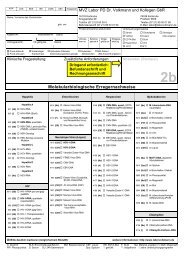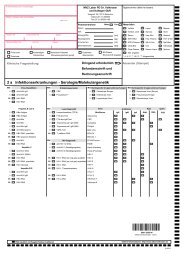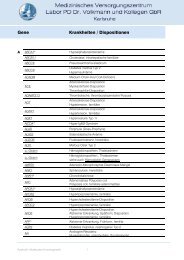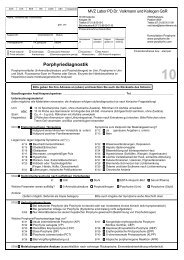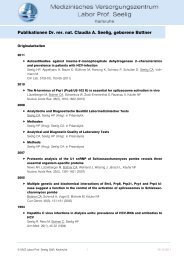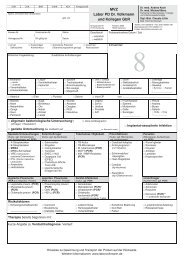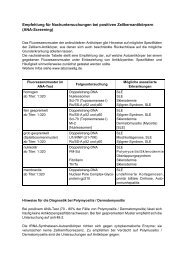ORIGINAL ARTICLE - MVZ Labor PD Dr. Volkmann und Kollegen
ORIGINAL ARTICLE - MVZ Labor PD Dr. Volkmann und Kollegen
ORIGINAL ARTICLE - MVZ Labor PD Dr. Volkmann und Kollegen
Create successful ePaper yourself
Turn your PDF publications into a flip-book with our unique Google optimized e-Paper software.
(36). Obviously, this state of molecule rearrangement<br />
may be induced also by other yet unknown factors as<br />
exemplified by its existence in certain commercial diagnostic<br />
HEp-2 cell preparations, unlikely having been<br />
subjected to prior MPA or ribavirin exposure. In this<br />
latter case the HEp-2 cell cultures may have been manipulated<br />
in an unknown manner, inducing the transition<br />
of IM<strong>PD</strong>H2 into the “rods and rings” state. As far<br />
as routine immunofluorescence tests are concerned,<br />
these observations and the fact that five out of seven<br />
commercial HEp-2 cell preparations were not able to<br />
detect anti-IM<strong>PD</strong>H2 exemplify to what extent different<br />
commercial cell substrates impinge on results and interpretations<br />
of the tests (Figure 1).<br />
As far as anti-IM<strong>PD</strong>H2 itself is concerned, certain differences<br />
may exist in its epitope specificity. Antibodies<br />
fo<strong>und</strong> in HCV-RNA carriers differ at least from those of<br />
the index patient in that they react preferentially with<br />
conformational epitopes.<br />
This is indicated by the fact that the index patient recognized<br />
recombinant IM<strong>PD</strong>H2 expressed in E. coli and<br />
subjected to denaturing conditions of western blot,<br />
whereas the antibodies fo<strong>und</strong> in HCV-RNA carriers,<br />
despite high antibody titers, showed only a very weak<br />
(western blots) or no reaction (line blots) with this<br />
source of antigen. However, the antibodies recognize<br />
IM<strong>PD</strong>H2 synthesized by in vitro transcription and translation<br />
in rabbit reticulocyte lysate and therefore probably<br />
displaying a higher degree of conformational structure.<br />
For this reason RIPA was used in this study for the<br />
evaluation of the prevalence of anti-IM<strong>PD</strong>H2. The<br />
existence of a broad diversity in epitope and conformational<br />
recognition also may be seen in the observation<br />
that the in house rabbit anti-IM<strong>PD</strong>H2 recognized the recombinant<br />
antigens in western blot and RIPA but neither<br />
the natural nor the “rods and rings” forms of IMP-<br />
DH2 in HEp-2 cells. Differences in epitope specificity<br />
also may be responsible for the low prevalence of anti-<br />
IM<strong>PD</strong>H2 (4.76 %) in patients with autoimmune hepatitis<br />
detailed by Quing at al. (10) using immunoproteomics,<br />
principally based on the western blot technology,<br />
which has been shown in this study to be less suited<br />
than the RIPA assay for detection of these antibodies.<br />
Using the immunoprecipitation assay, we detected anti-<br />
IM<strong>PD</strong>H2 in low concentrations in 31 % of the patients<br />
with suspected autoimmune hepatitis. The high prevalence<br />
of anti-IM<strong>PD</strong>H2 in patients with colorectal carcinoma<br />
demonstrated by immunoproteomics by He et al.<br />
(11), on the other hand, may speak in favor of the existence<br />
in those patients of anti-IM<strong>PD</strong>H2 preferentially<br />
reacting with denatured antigens. To clarify these presumptions,<br />
however, detailed studies of epitope specificities<br />
in various groups of anti-IM<strong>PD</strong>H2 positive patients<br />
are necessary.<br />
The reason for the high prevalence of anti-IM<strong>PD</strong>H2 in<br />
HCV-RNA carriers remains obscure. Generally, the occurrence<br />
of a new autoantibody in patients with HCVinfections<br />
is not very surprising since an augmentation<br />
of immunological disorders (e. g. mixed cryoglobulin-<br />
AUTOANTIBODIES AGAINST IM<strong>PD</strong>H2 AND HCV INFECTION<br />
Clin. Lab. 9+10/2011 763<br />
emia, thyroid disorders, arthritis, vasculitis, Sjögren<br />
syndrome, lung fibrosis) (37 - 39), and of autoantibodies<br />
such as smooth muscle antibodies, rheumatoid<br />
factor, liver-kidney-microsomal antibodies, anticardiolipin,<br />
antinuclear antibodies, cryoglobulins, thyroid<br />
antibodies or ribosomal P protein antibodies (12–<br />
17,40,41) as well as a correlation between the occurrence<br />
of antibodies and disease activity (42,43) have<br />
been proposed. Furthermore, treatment with interferonalpha<br />
commonly used in HCV-RNA carriers may render<br />
them more susceptible for developing autoantibodies<br />
and less frequently autoimmune diseases (e. g.<br />
Hashimoto thyroiditis, lupus erythematosus or type 1<br />
diabetes) (47-49).<br />
The reported figures for the prevalence of autoantibodies<br />
in HCV infections vary considerably (e. g. antinuclear<br />
antibodies 10 – 21 %, smooth muscle antibodies<br />
10 – 55 %) whereas in patients lacking active liver disease<br />
the prevalence of autoantibodies seems not to be<br />
significantly increased as compared to healthy controls<br />
(43-46). It has been suggested, that for antibody development<br />
host features especially continuous liver cell<br />
damage and hepatocyte necrosis are likely to be more<br />
important than viral factors, e. g. HCV-genotype (46).<br />
In line with this, we also did not find a correlation between<br />
the development of anti-IM<strong>PD</strong>H2 and virus load.<br />
Ribavirin, widely used in therapy for HCV infection, introduces<br />
profo<strong>und</strong> alterations of the intracellular distribution<br />
of IM<strong>PD</strong>H2 and therefore possibly enhances its<br />
immunogenicity. According to our information all anti-<br />
IM<strong>PD</strong>H2 positive patients were subjected to ribavirin<br />
therapy, but detailed data concerning the time elapsed<br />
between therapy and antibody testing or the duration of<br />
therapy etc. could not be made available. A vague link<br />
between ribavirin and anti-IM<strong>PD</strong>H2 may be seen in the<br />
trend of a lower HCV-RNA load in patients exhibiting<br />
higher anti-IM<strong>PD</strong>H2 levels (Figure 6). To answer these<br />
questions, prospective studies considering therapy, activity<br />
of liver disease, and concomitant autoimmune<br />
phenomena are needed.<br />
A high prevalence (31 %) of anti-IM<strong>PD</strong>H2 in low concentrations<br />
(Figure 6) also was fo<strong>und</strong> in patients with<br />
clinical suspicion of autoimmune hepatitis (AIH) and<br />
harboring actin-antibodies (titer 1: >80), demonstrated<br />
by IIFT (liver of phalloidin treated mice and vinblastine<br />
treated HEp-2). However, detailed information concerning<br />
the state of liver disease (activity, remissions)<br />
and therapy were not available, neither from these patients<br />
nor from those with the suspicion of primary biliary<br />
cirrhosis (PBC) harboring mitochondrial antibodies<br />
of type M2-specificity. In general, the casual occurrence<br />
of anti-IM<strong>PD</strong>H2 or other autoantibodies (10) in patients<br />
with AIH or PBC, intrinsically prone to exhibit autoimmune<br />
phenomena, may not be surprising. Based on our<br />
more “hypothetical” diagnoses, it seems that in AIH<br />
with a rather high prevalence of low titer anti-IM<strong>PD</strong>H2<br />
specific pathological processes may govern the formation<br />
of anti-IM<strong>PD</strong>H2 not prevailing in PBC where the<br />
prevalence of anti-IM<strong>PD</strong>H does not exceed that of con-



